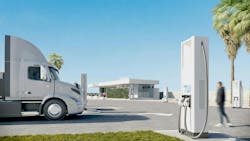What goes into planning an electric truck charging station?
Charging stations for electric heavy-duty trucks are cropping up across the U.S.
Battery-electric Class 8 vehicles have a growing presence in freight and federal agencies have outlined EV charging infrastructure development for freight corridors over the next 15 years.
However, as a report by the North American Council for Freight Efficiency states, long-haul BEVs are still just speculation for the future. While some U.S. pilot programs are testing out long-haul BEVs, most charging infrastructure today serves medium-duty urban delivery and heavy-duty drayage movement.
Still, fleet leaders looking into the future can familiarize themselves with the processes behind charging infrastructure. Among those processes, planning is the first step.
See also: FirstElement brings heavy-duty hydrogen fueling capabilities to the masses
Gather information
A fleet won’t likely jump straight into building a 10-charger station for a fully-electric fleet. Managers generally explore the opportunities and challenges involved in creating and operating a charging station.
Small-scale testing
Gathering information often includes testing electrification at a smaller scale before beginning the hands-on work to build a dedicated charging station.
Atom Power, a technology company focused on electric vehicle charging infrastructure, noticed a similar timeline for EV charging infrastructure development across its customer companies and municipalities.
“Typically, there is an initiative at the executive level ... that sets a goal,” Ryan Kennedy, co-founder of Atom Power, told FleetOwner. “That’s generally what we’re seeing, pretty much across the board. And that gets pushed out to their facility managers, that then say, ‘OK, we have to figure out how to do this both on the vehicle purchasing and also on the infrastructure side.’”
Then, Kennedy said, the company or municipality will start with a few vehicles and chargers to test the waters. By the end of that pilot, the organization should have learned much more about EV operations.
See also: Scaling charging infrastructure: Where to begin
While Kennedy noticed that organizations tended to start with an executive goal and initial pilot, charging infrastructure rollout seems to vary widely outside of that trend.
“There’s no set formula other than there tends to be this trend: there’s a ‘try it first and then learn’—which is a very good idea in this case, because there are a lot of nuances to electric vehicle charging infrastructure to learn from,” Kennedy explained. “Then, from those learnings, to then say ‘OK, what do we use?’”
From this point, some fleets will opt to develop their own dedicated charging stations—or to develop a shared station with a nearby fleet. Here, the hands-on work to design and build a charging station begins.
From charging station planning to operation
Emilia Sibley, head of solutions for charging infrastructure company Terawatt, said the company's typical timeline from planning to operation is about 18 months.
“The typical process starts with identifying the property, doing due diligence on that property to make sure it checks all our boxes, and then acquiring or leasing the property itself,” Sibley told FleetOwner.
That process includes evaluating the site's power availability, such as its proximity to a substation that has adequate capacity or plans for future capacity, as well as its proximity to freight activity or convenient vehicle access.
Mike Roeth, executive director of NACFE, noted that the site planning process can help to identify where charging infrastructure makes sense.
“There’s the site planning: where am I going to put the chargers? Do I want them near the docks? Do I want them near an entry? Do I want them different places around the property?” Roeth told FleetOwner. “Sometimes it’s better or cheaper to bring power on the north side of the property than the south side. There’s a lot of consideration on the layout, the footprint, and the charging.”
Utility capacity
A significant influence on site planning is the power utility’s capacity for a given location.
“The utility has a process to go through—they call it a load request,” Roeth said. “You put in a load request that says, ‘I need additional power at this site.’”
See also: NPTC partners with NACFE and Clean Freight Coalition
In response to a commercial/industrial load request, the local power utility can assess the location’s available power. Lucky developers will find that the location already has capacity for their power needs; unlucky developers will find that the utility needs to add capacity to its distribution system. These capacity upgrades can take a long time, according to Kennedy.
“On the utility side, if the utility requires upgrades, it almost always means changing out the transformer to some bigger one,” Kennedy told FleetOwner. “That is where pain points emerge from a timing perspective. We have seen utilities, particularly in California and the northeast areas of the country, that have 72 weeks plus lead time on transformer upgrades.”
Because of this, ensuring utility capacity is one of the most important first steps in determining an appropriate site for chargers. Once the developers find an appropriate site, they can begin design.
Site design
“We then go into the site design process and interconnection with the utility to bring power to the site,” Sibley said. “That can take many, many months and sometimes years, so we like to start that process as early as possible.”
Within the site design process includes entitlements and permitting, making sure that the property meets station code requirements, specifying equipment, identifying contractors, and more.
After the site design process comes the main equipment procurement for necessary items, such as the switchgear and the chargers themselves. Then comes construction, commissioning, and finally operation.
“It’s not so sequential; there’s overlap of these different phases, so we’re constantly juggling, identifying the longest pole in the tent, so to speak, to make sure that we’re moving as fast as possible to get these charging stations online,” Sibley said.
This is part one of a two-part series on EV charging station development. Read part two here.
About the Author
Jeremy Wolfe
Editor
Editor Jeremy Wolfe joined the FleetOwner team in February 2024. He graduated from the University of Wisconsin-Stevens Point with majors in English and Philosophy. He previously served as Editor for Endeavor Business Media's Water Group publications.

